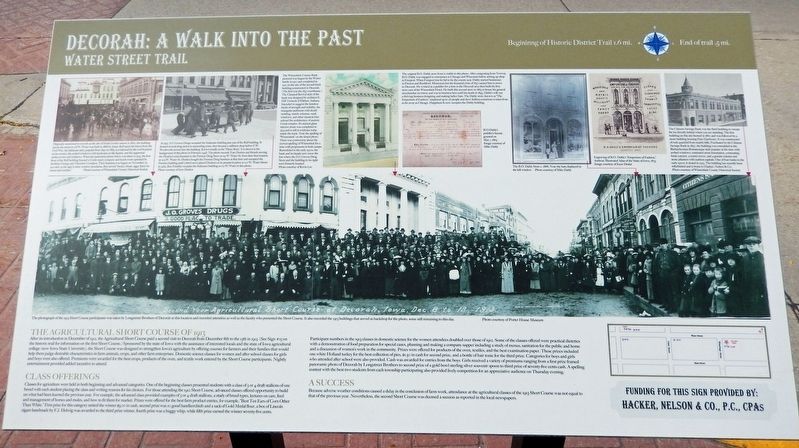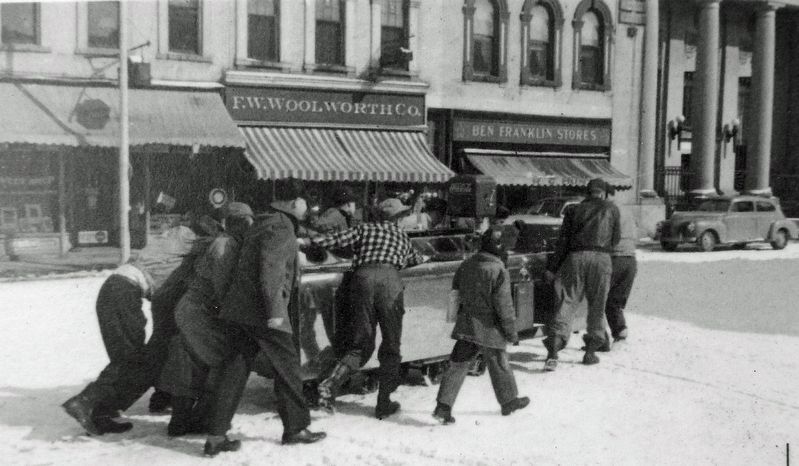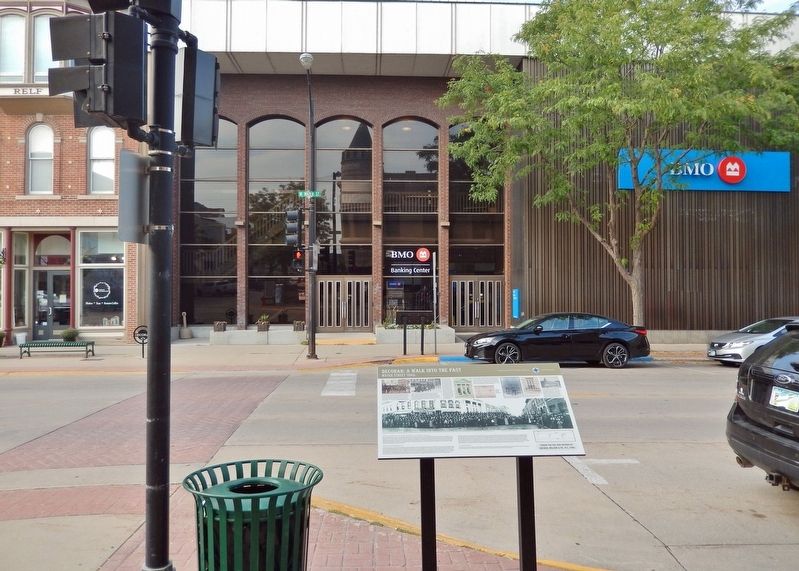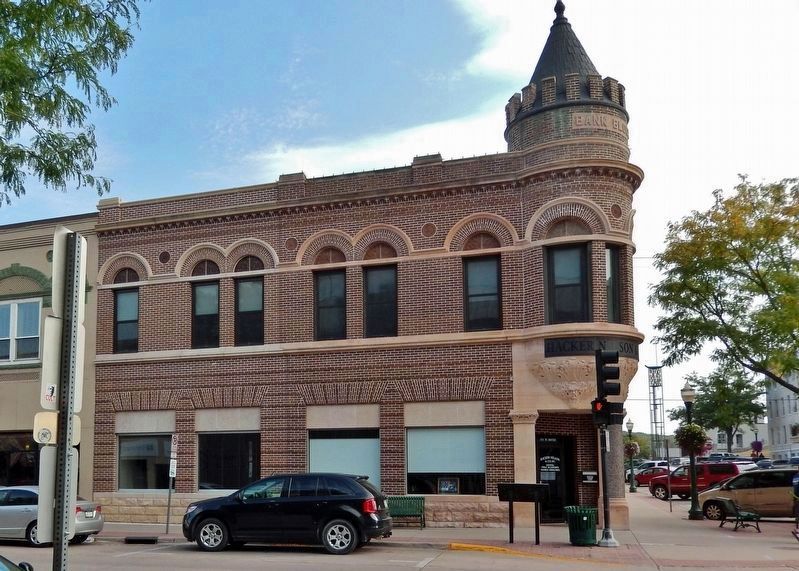Decorah in Winneshiek County, Iowa — The American Midwest (Upper Plains)
Decorah: A Walk into the Past
Water Street Trail
The Agricultural Short Course of 1913
After its introduction in December of 1912, the Agricultural Short Course paid a second visit to Decorah from December 8th to the 13th in 1913. (See Sign #15 on the historic trail for information on the first Short Course.) Sponsored by the state of Iowa with the assistance of interested locals and the state of Iowa agricultural college (now Iowa State University), the Short Course was designed to strengthen Iowa's agriculture by offering courses for farmers and their families that would help them judge desirable characteristics in farm animals, crops, and other farm enterprises. Domestic science classes for women and after school classes for girls and boys were also offered. Premiums were awarded for the best crops, products of the oven, and textile work entered by the Short Course participants. Nightly entertainment provided added incentive to attend.
Class Offerings
Classes for agriculture were held in both beginning and advanced categories. One of the beginning classes presented students with a class of 3 or 4 draft stallions of one breed with each student placing the class and writing reasons for his choices. For those attending the 1912 Short Course, advanced classes offered opportunity to build on what had been learned the previous year. For example, the advanced class provided examples of 3 or 4 draft stallions, a study of breed types, lectures on care, feed and management of horses and mules, and how to fit them for market. Prizes were offered for the best farm product entries, for example, “Best Ten Ears of Corn Other Than White.” First prize for this category netted the winner $5.00 in cash, second prize was 10 good handkerchiefs and a sack of Gold Medal flour, a box of Lincoln cigars handmade by F.J. Helwig was awarded to the third prize winner, fourth prize was a buggy whip, while fifth prize earned the winner seventy-five cents.
Participant numbers in the 1913 classes in domestic science for the women attendees doubled over those of 1912. Some of the classes offered were practical dietetics with a demonstration of food preparation for special cases, planning and making a company supper including a study of menus, sanitation for the public and home and a discussion of women's work in the community. Prizes were offered for products of the oven, textiles, and the best examination paper. These prizes included one white Holland turkey for the best collection of pies, $1.50 in cash for second prize, and a bottle of hair tonic for the third prize. Categories for boys and girls who attended after school were also provided. Cash was awarded for entries from the boys. Girls received a variety of premiums ranging
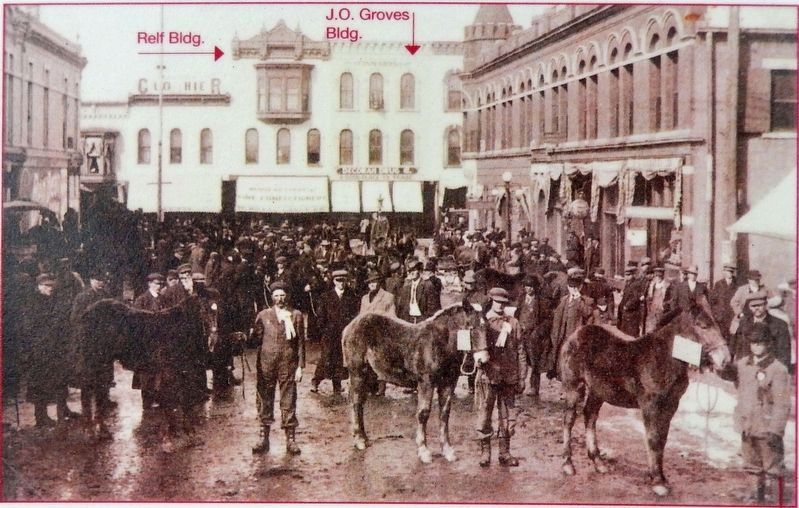
Winneshiek County Historical Society
2. Marker detail: Relf Building, 1913
Originally mentioned in records as the site of Hank Gerde’s saloon in 1860, the building across the street at 128 W. Water was built in 1868 by James Relf upon his return from the Civil War. Its Italianate style, popular from 1840 to 1885, is evidenced by the roof brackets on its cornice, the arched windows with keystones on the façade, and the segmental arches on its oriel windows. When the panoramic photo below was taken in 1913, the first floor of the Relf building housed a Greek candy company and lunch room operated by brothers George and Theodore Costakos. Their business was begun on November 27, 1911 and, as the sign in their window proclaims, they served “steaks, chops, eggs, fancy ice cream and candies.”
Success
Because adverse weather conditions caused a delay in the conclusion of farm work, attendance at the agricultural classes of the 1913 Short Course was not equal to that of the previous year. Nevertheless, the second Short Course was deemed a success as reported in the local newspapers.
[other photo captions]
• The Winneshiek County Bank pictured was begun by the Weiser family in 1910 and completed in 1912 on the site of the second brick building constructed in Decorah. (The first was the 1857 courthouse.) The Classical Revival style of the bank was designed by architect E. Hill Turnock of Elkhart, Indiana. Intended to suggest the timeless ideals of strength and stability, the triangular pediment with dentil molding, stately columns, oculi windows, and other classical trim echoed the architecture of ancient Greek temples. Its stained-glass interior dome was completed in 1913 and is still in evidence today inside the bank. Note the spelling of "Winnesheik" on the tinted photo. Therewas controversy about the correct spelling of Winneshiek for a time with proponents in both camps. Remodeled in the early 1970s, the bank and its façade now cover the lots where the J.O. Groves Drug Store and the building to its right were formerly located.Courtesy Jerry Donlon3. Marker detail: Moving the Donlon Soda Fountain, 1948In 1913 J.O. Groves Drugs occupied the Italianate building just east of the Relf building. It housed several drug stores in succeeding years, then became a millinery shop before F. W. Woolworth moved into the building. Known locally as the “Dime Store,” it is shown in the background of this photo in February 1948. The photo records Tom Donlon and friends moving the Donlon's soda fountain to the Parman Drug Store at 119 W. Water St. from their first location at 205 W. Water St. Donlon bought the Parman Drug business at that time and occupied the Parman building until a third move placed Donlon's at its present location at 201 W. Water Street in 1963. Ben Franklin occupies the Italianate building at 122 W. Water in this photo.
• B.O. Dahly’s peddler’s license granted on May 1, 1863.
• The B.O. Dahly Store c. 1868. Note the hats displayed in the left window. The original B.O. Dahly store front is visible in this photo. After emigrating from Norway, B.O. Dahly was engaged in enterprises in Chicago and Wisconsin before setting up shop in Freeport. When Freeport lost its bid to be the county seat, Dahly started businesses in Preston and Rushford, Minnesota but the financial crisis of 1857 caused him to move to Decorah. He worked as a peddler for a time in the Decorah area then built his first store east of the Winneshiek Hotel. He built this second store in 1865 to house his general merchandise inventory and was in business here until his death in 1895. Dahly's wife ran a thriving business designing and making ladies' hats. The Dahly store, known as “The Emporium of Fashion,” employed up to 26 people and drew fashion-conscious women from as far away as Chicago. “Happiness Is” now occupies the Dahly building.
• The Citizens Savings Bank was the third building to occupy the lot directly behind where you are standing. The first building on thissite burned in 1860 and was followed by a stone building housing Finn Hardware. It was constructed of rock quarried from nearby hills. Purchased by the Citizens Savings Bank in 1897, the building was remodeled in the Richardsonian Romanesque style popular at the time with arched windows, rusticated stone foundation, contrasting brick exterior, a corner tower, and a granite column and stone pilasters with cushion capitals. One of four banks in the early 1900s, it closed in 1923. The building has recently been refurbished and is home to Hacker, Nelson & Co.Courtesy Porter House Museum, 19134. Marker detail: The 1913 Short Course ParticipantsThe photograph of the 1913 Short Course participants was taken by Longstreet Brothers of Decorah at this location and recorded attendees as well as the faculty who presented the Short Course. It also recorded the 1913 buildings that served as backdrop for the photo, some still remaining to this day.
Funding for this sign provided by: Hacker, Nelson & Co., P.C., CPAs
Topics. This historical marker is listed in these topic lists: Agriculture • Architecture • Education • Industry & Commerce. A significant historical year for this entry is 1913.
Location. 43° 18.247′ N, 91° 47.222′ W. Marker is in Decorah, Iowa, in Winneshiek County. Marker is at the intersection of West Water Street and Winnebago Street, on the left when traveling west on West Water Street. The marker is located along the sidewalk at the southeast corner of the intersection. Touch for map. Marker is at or near this postal address: 123 West Water Street, Decorah IA 52101, United States of America. Touch for directions.
Other nearby markers. At least 8 other markers are within walking distance of this marker. A different marker also named Decorah: A Walk into the Past (about 300 feet away, measured in a direct line);
a different marker also named Decorah: A Walk into the Past (about 300 feet away); Winnebago Street (about 300 feet away); a different marker also named Decorah: A Walk into the Past (about 300 feet away); "The Biggest Day in the History of the County" (about 400 feet away); Replica of the Statue of Liberty (about 500 feet away); Decorah, Northeast Iowa, & the Neutral Ground (about 600 feet away); To Build, or Not To Build (about 600 feet away). Touch for a list and map of all markers in Decorah.
Credits. This page was last revised on February 23, 2024. It was originally submitted on February 23, 2024, by Cosmos Mariner of Cape Canaveral, Florida. This page has been viewed 39 times since then. Photos: 1, 2, 3, 4, 5, 6. submitted on February 23, 2024, by Cosmos Mariner of Cape Canaveral, Florida.
